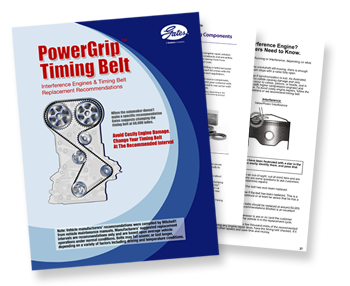Important Timing Belt Service Information
If your vehicle’s engine is a 4- or 6-cylinder, chances are it has a timing belt. Some import V-8s have them too. You can check your owner’s manual scheduled maintenance section. Timing belts need to be changed at a scheduled service interval. Intervals range anywhere from 60,000 miles up to 105,000 depending on the vehicle year, make, model and engine type. Timing belts should also be changed based on time. Honda, for example, recommends changing some of their belts after 72 months regardless of mileage.
Remember, you cannot safely judge a timing belt’s condition by looking at it. Always consider the length of service and mileage on the vehicle.

What is a Timing Belt?
A timing belt is flat, rubber belt with teeth. It connects the camshaft and crankshaft inside the engine much like a bicycle chain connects the front and rear sprocket. But more importantly it synchronizes the rotation of the valves and pistons to occur at the correct times. Timing belts have replaced chains in many cars today and help make the sophisticated engines we find under the hood possible.
What happens When A Timing Belt Breaks?
Your vehicle comes to an immediate stop. But there is more. The good news is you will need to be towed to a repair shop to replace the belt. The bad news is your engine may have suffered major internal damage. This can result in more than just timing belt replacement. You may need a new engine!
Change The Water Pump Too
If your timing belt drives the water pump (and chances are it does), change that also. A water pump failure can break the timing belt, which defeats why you change the timing belt as maintenance in the first place.

Want to check when your car is due for a belt change?
